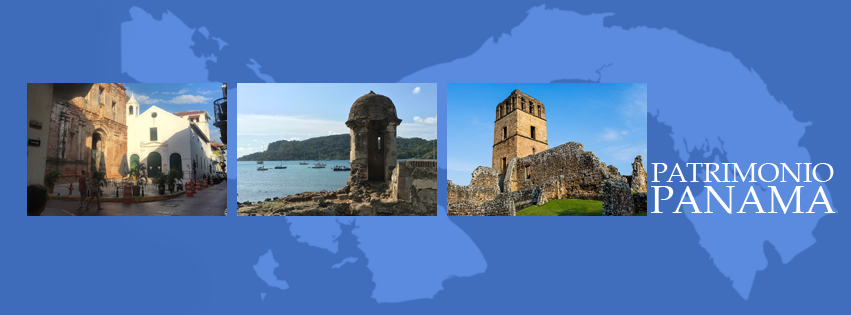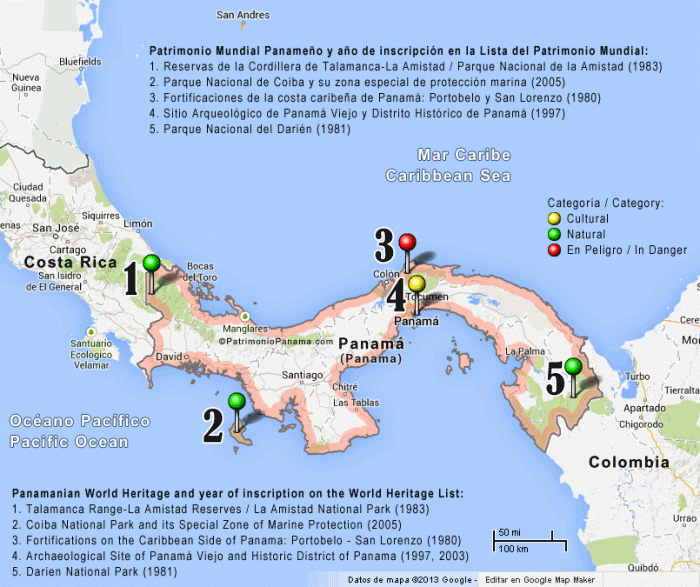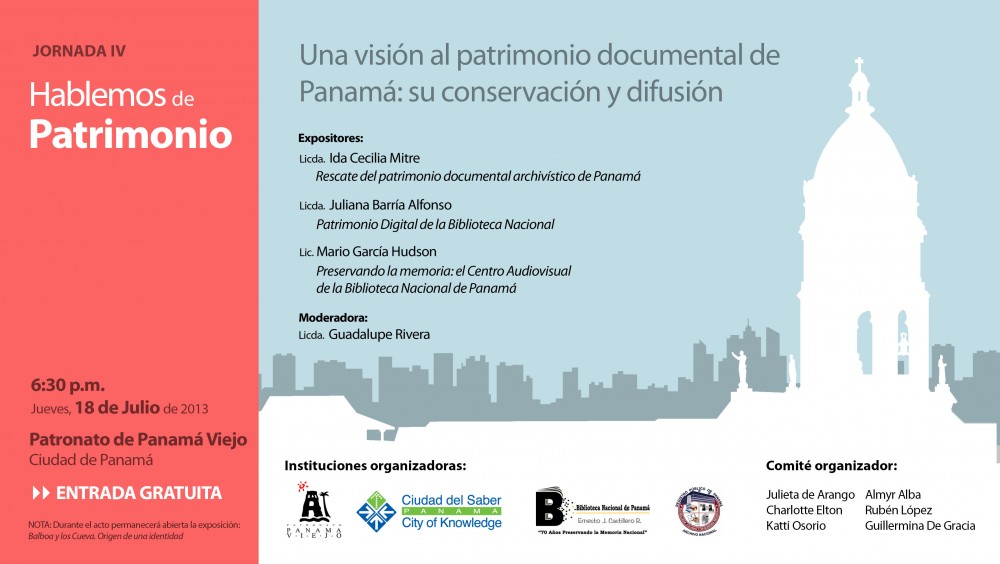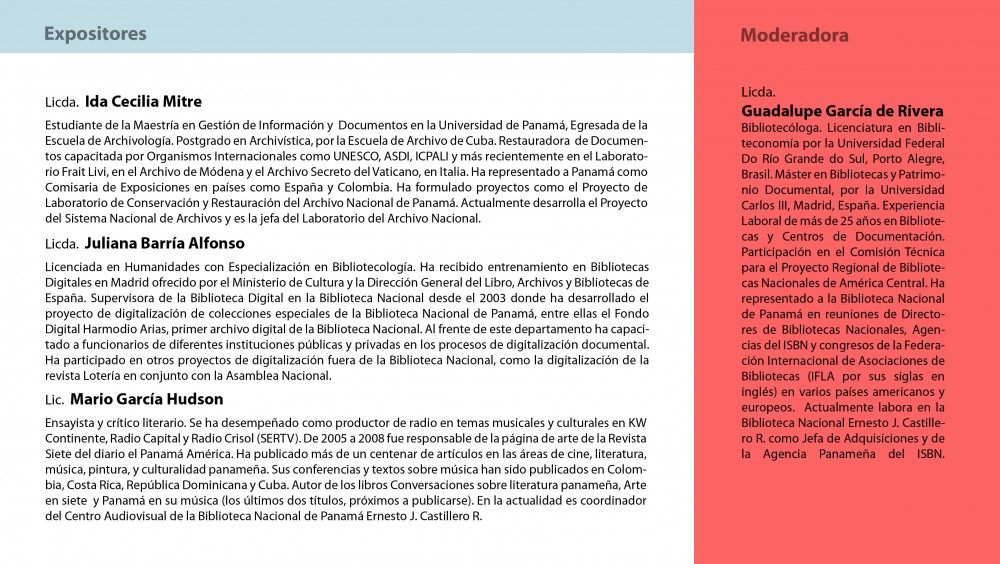Dear Friends of Patrimonio Panama:
Up to this date, Panama has under inscription on UNESCO's World Heritage List, the property “Archaeological Site of Panama Viejo and Historic District of Panama.” Casco Antiguo is another name for the Historic District of Panama City, as it is known in Spanish language. In order to enter the World Heritage List(1), As State Party to the World Heritage Convention, Panama justified to the World Heritage Committee of Unesco, that the property holds outstanding universal value, by means of demonstrating that the property meets the necessary requirements, which include meeting at least one of the ten criteria of outstanding universal value. The property in its two components, Casco Antiguo + Panama Viejo, met criteria (ii), (iv) and (vi). The criteria nomenclature is written in lowercase Roman numerals.
Each criterion of outstanding universal value has a theoretical basis, that supports them. I would like to showcase the sixth criterion (vi) of outstanding universal value, justified for the Archaeological Site of Panama Viejo and Historic District of Panama. I selected criterion (vi) because today is a special day: It is Panama's Independence from Spain (and affiliation to Colombia) on the 28 of November, 1821. At that date, Simón Bolívar El Libertador wrote a few congratulating lines to General Jose de Fabrega in occasion of the independence of the Isthmus of Panama. These lines were precursory to the Amphictyonic Congress of Panama, which is the basis of the Panamanian justification for criterion (vi) to the World Heritage Committee on the inscription of the Historic District of Panama on the World Heritage List in 1997. Before examining the letter, let us see the criterion (vi) of outstanding universal value for the Archaeological Site of Panama Viejo and Historic District of Panama:
Current Version: Decision 37 COM 8E, Retrospective Statement of Outstanding Universal Value
Criterion (vi): The ruins of Panama Viejo are closely linked to the European discovery of the Pacific Ocean, the history of Spanish expansion in the Isthmus of Central America and in Andean South America, the African diaspora, the history of piracy and proxy war, the bullion lifeline to Europe, the spread of European culture in the region and the commerce network between the Americas and Europe. The Salón Bolívar is associated with Simón Bolívar's visionary attempt 1826 to establish a multinational congress in the Americas, preceding the Organization of American States and the United Nations. (UNOFFICIAL translation by the author)
In my paper, “The Attributes of Outstanding Universal Value of a property considered World Heritage – The case of the Archaeological Site of Panama Viejo and Historic District of Panama”, I made an analysis on the justification for the criteria of outstanding universal value presented by Panama that achieved the registration of the property in two stages as previously mentioned, in 1997 and 2003. I referred to each of the three criteria justified by Panama in regards to both components of the property: these are, The Historic District of Panama, and the Archaeological Site of Panama Viejo, identifying their corresponding attributes, where I pointed out in the case of criterion (vi) for the Historic District of Panama:
Criterion (vi) relates directly to the geopolitical importance of the strategic position of Panama City, from its foundation and relocation to the present day. The criterion is thus justified, based on the Bolivarian idea of making Panama the venue for the Amphictyonic Congress of Panama, considering Panama to be the logical place from the standpoint of strategy and geopolitics, in the vision of a free America, in a position to discuss as equals with European powers and the new nations in the North American continent, to achieve global balance. Even, the idea and the Congress itself, are precursors of international organizations with similar goals (the United Nations, and the Organization of American States, among others). Without the geopolitical importance attributed to Panama City by Simón Bolívar El Libertador, the Amphictyonic Congress of Panama would not have taken place there. Thus, criterion (vi) is more based on the idea of a congress of nations seeking a world balance, than on the ruins of Salón Bolívar itself, which is credited with being the room that hosted the Congress. The ruins are the physical attribute of the space that hosted the idea.
The attributes present in the justification of criterion (vi) are: the Salón Bolívar (at Bolívar Palace, headquarters of the Ministry of Foreign Affairs); and the maritime character of the city of Panama, main part of its geopolitical importance as a strategic point for inter-oceanic communications, and terminal of international trade routes. (Osorio 2012: 14-15)
I would like to draw your attention to the Bolivarian idea of making Panama the venue for the Amphictyonic Congress. In his famous Letter from Jamaica (as translated by Lewis Betrand in, Selected Writings from Bolivar. New York: The Colonial Press, 1951), Bolivar made reference to the Isthmus of Panama three times, first, referring to the Isthmus as possible capital city, after Mexico, of the New World, made into a great republic, and described the Isthmus of Panama as “… Let us assume it were to be the Isthmus of Panama, the most central point for all of this vast continent…” (Bolívar 1967: 38). In his second allusion to the Isthmus of Panama, he points out: “The states of the Isthmus of Panama as far as Guatemala, will perhaps form a confederation. Because of their magnificent position between two mighty oceans, they may in time become the emporium of the world, Their canals will shorten distances throughout the world, strengthen commercial ties between Europe, America and Asia, and bring to that happy area tribute of the four quarters of the globe. There some day, perhaps, the capital of the world may be located - reminiscent of the Emperor Constantine's claim that Byzantium was the capital of the ancient world!” (Bolívar 1967: 42-43). Noting the great difficulties in maintaining peace in the newly founded territories and the impossibility to consolidate them into a single, mighty republic, he makes reference to Panama for the third time, saying: “How beautiful it would be if the Isthmus of Panama could be for us what the Isthmus of Corinth was for the Greeks! Would to God that someday we may have the good fortune to convene there an august assembly of representatives of republics, kingdoms and empires to deliberate upon the high interests of peace and war, with the nations of the other three quarters of the globe.” (Bolívar 1967: 47).
The thoughts on Bolivar's mind concerning the Isthmus of Panama, embodied in his Letter from Jamaica 1815 addressed to an English gentleman in Kingston, Jamaica, was focused on the geopolitical importance of the geographic position of the Isthmus of Panama. He enthusiastically described the Isthmus of Panama, as a central point for all the Americas; assures that the Isthmus of Panama would become the emporium of the world thanks to its privileged interoceanic communications, including future canals; and that the Isthmus of Panama would strengthen commercial ties between Europe, the Americas and Asia; and he even goes as far as to give it the capital of the globe; Bolívar then reinforces the thought by equating the Isthmus of Panama to the Isthmus of Corinth and saying that Panama would be venue for a future world congress of republics, kingdoms and empires.
Perusing over documents on the internet related to present date November 28th, I found a transcription of the letter El Libertador Simón Bolívar addressed to General José de Fábrega on February 1st 1822, on the occasion of the independence of Panama from Spain. The letter to General Fábrega, back then still a colonel, was written seven years after the Letter of Jamaica; seven years during which the idea of a congress of nations remained brewing on El Libertador's mind..
I took the liberty to transcribe (and translate) the letter, as follows. I used bold letters to enhance some of the text, to highlight those terms that showcase the special interest Bolívar had on the case of Panama.
Headquarters at Popayán, 1February 1st, 1822 - 12º
TO MISTER COLONEL JOSÉ DE FÁBREGA,
GOVERNOR COMMANDER GENERAL
OF THE PROVINCE OF PANAMA.Mister Colonel:
Yet without having had the satisfaction of receiving the dispatch that. you. have been kind enough to address to me, I hasten to congratulate the distinguished province that. you. have the glory of presiding over. I cannot fully express the feelings of joy and wonder I have experienced upon learning that Panamá, the center of the universe, is regenerated by her own volition, and free by her own virtue. The Act of Independence of Panama, is the most glorious monument that any American province may offer to History. Everything is consulted there, in regards to justice, generosity, politics and general interest.
Do convey on my behalf. you. to those meritorious Colombians, the tribute of my enthusiasm for their pure patriotism and true generosity. Without delay, a part of the army of Colombia, under the command of Colonel Carreño, must have secured already the fate of that precious emporium of commerce and exchange of the world. I have also ordered a second army corps of a 1.000 more men, enter to replace those same troops I now request from their commander to come and join us to cooperate to the freedom of Quito. Thus you. Colonel Fábrega. shall make every effort to ensure that these orders are carried out to their full effect. I trust completely that you. you. shall give all the assistance within your power to ensure that these troops may depart immediately with all the elements necessary for their transport and operations, due to embark for the coast of Esmeraldas and Guayaquil under the command of whomever leader gets appointed to them by Colonel Carreño: and embarking on the transports and warships that may be procured eventfully at the Isthmus ports or on the warships that may be expressly sent for that purpose from Guayaquil. Thus you. Mister, Colonel, are hereby appointed by me as governor commander general of the province of Panama, and Mister Colonel Carreño and should remain in command in that military department, as head, of politics and military, in charge of operations against Veraguas, or any other point occupied by the Spanish armies on the borders of Colombia. Mister Colonel Carreño shall receive from the department of Magdalena and the capital of Bogotá as much support as needed for the defense od the work you have so. you. initiated. I reiterate to you. you. expression of sincere gratitude, with which I accepted on behalf of Colombia the services that you. you. and that generous people have done to thus complete, the scope that Providence and Nature had designed to our mighty republic. May God keep you. you. long and many years.
BOLÍVAR.
To Bolivar, Panama was the center of the universe; probably, a geopolitical universe built upon vast communication networks. Four years later, he held in Panama City his long-awaited congress…. but, in what conditions was Panama City when it hosted the Amphictyonic Congress of Panama 1826?
A quick look at two cartographic references may show us Panama City at the time of the of Amphictyonic Congress of Panama 1826: Map of Panama in 1814, and the map of Panama in 1850. Both maps show the city in ruins, with more than 30% of its occupation area marked as uncultivated land, in ruins, or covered with bushes 1850, in better off conditions than in 1814.

Figure 1. Plan of the Plaza de Panama, chorographic Map of the New Kingdom of Granada, by Vicente Talledo y Rivera, 1814 (Tejeira 2009: 40)

Figure 2. Map of Panama in 1859, by H. Tiedemann (Spadafora 2001: 37).
Concluding remarks
Panama City was far from being an affluent city in 1826, the city was under a slow economic period and had a less than attractive appearance. Nonetheless, Simón Bolívar El Libertador was convinced about the geopolitical importance of the geographic position of the Isthmus of Panama, as shown in his Letter from Jamaica 1815, and his letter to General José de Fábrega in 1822. Bolívar summoned kingdoms, republics and empires to the Amphictyonic Congress of Panama in 1826. Regardless of its outcome, the Amphictyonic Congress of Panama in 1826 was a milestone in world history and it is precursor of current leagues of nations such as the United Nations, and the Organization of American States. This would not have come to happen if El Libertador had not been fully convinced of the importance of Panama as a communications hub, with great potential for locating a canal, and to become a commercial emporium accessible throughout the Americas, Europe and Asia. The sea was a vital element for the realization of this dream, and Panama with its important port connections, would fulfill an extraordinary role for the joint progress, “to our mighty republic” (Bolívar 2013). The room where the Amphictyonic Congress presumably took place, identified as the refectory of the convent of San Francisco, was restored in the early 2000. This is the space that housed the idea; the room's existence with all its ideological associations and interpretation of its wider setting give justification to the criterion (vi) of outstanding universal value, in accordance to the integrity of its attributes.
As I noted in a previous work, “To maintain the validity of Criterion (vi) the preservation of the elements that outline the strategic position of Panama City should be taken into account: its marine environment, access and communication with the sea (being a maritime city since 1519 and kept in its second phase from 1673), and its access and communication by land” (Osorio 2012: 22). This is, because of the geopolitical importance of the geographic position of the Old Town of Panama which cannot be understood without the sea that gives access to its port and environs., surrounding the peninsula where the Historic District was built.
As a final consideration, quote the Article 10 of Law Nº. 16 of 22 of May 2007:
"The institutions of the State shall ensure that the Historic Monuments Groups of Panamá Viejo and Casco Antiguo of the City of Panamá shall maintain their historic relationship, their visual contact and immediate access to the Pacific Ocean, and, accordingly, shall preserve their marine environment, which is part of the integral value of both Groups".
Regards,
Katti Osorio
o——o——o——o
References
Bolívar, Simón (2013) Letter addressed to Mr. Coronel José De Fabrega Gobernardor Commanding General of the Province of Panama, Headquarters at Popayán, 1° of February 1822. University of Los Andes, Venezuela.
Bolívar, Simón (1967) Letter from Jamaica. Publishing House of Culture. Miranda State Government, Venezuela.
Osorio, Katti (2012) The Attributes of Outstanding Universal Value of a property considered World Heritage – The case of the Archaeological Site of Panama Viejo and Historic District of Panama. Canto Rodado, 7 (7). pp. 1-27. ISSN 1818-2917 [Article]
Tejeira Davis, Eduardo (2009) In Panama 1814: city plans of Vicente Talledo y Rivera. Canto Rodado, 4 (4). pp. 37-74. ISSN 1818-2917 [Article]
Spadafora, Vanessa; Tejeira Davis, Eduardo (2001) El Casco Antiguo de Panama. 2 vols. City-City, Bilbao.
Notes:
(1) The property, “Archaeological Site of Panama Viejo and Historic District of Panama” was inscribed as such on the World Heritage List in two stages. In 1997, the World Heritage Committee inscribed the equivalent part of the Historic Old Town Set Monumental City Panama delimited by Law No. 91 of 22 December 1976, under the name “Historic District of Panama with the Salon Bolivar” (Casco Antiguo de Panamá con el Salón Bolívar). Later on, without changing the boundaries of the Historic District of Panama, which continued to correspond to those declared by Law 91 of 22 December 1976, the Archaeological Site of Panama Viejo was inscribed as an extension of the Historic District, according to their boundary delineated by the same Law, and the name of the property was changed to its current name. Thus was settled the World Heritage property, “Archaeological Site of Panama Viejo and Historic District of Panama.”

















